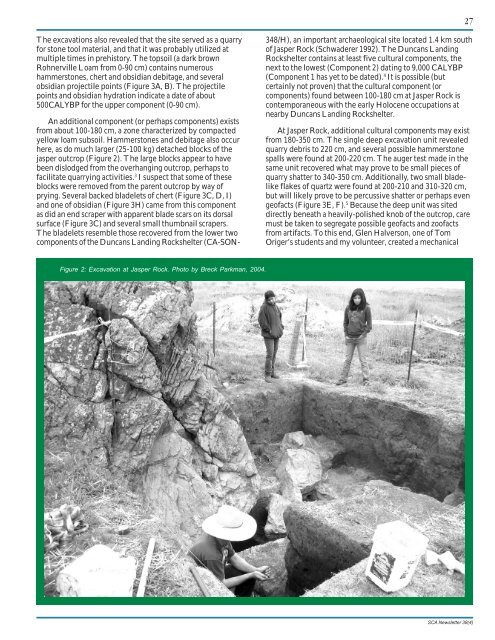Mammoth Rub Update - Society for California Archaeology
Mammoth Rub Update - Society for California Archaeology
Mammoth Rub Update - Society for California Archaeology
You also want an ePaper? Increase the reach of your titles
YUMPU automatically turns print PDFs into web optimized ePapers that Google loves.
The excavations also revealed that the site served as a quarry<br />
<strong>for</strong> stone tool material, and that it was probably utilized at<br />
multiple times in prehistory. The topsoil (a dark brown<br />
Rohnerville Loam from 0-90 cm) contains numerous<br />
hammerstones, chert and obsidian debitage, and several<br />
obsidian projectile points (Figure 3A, B). The projectile<br />
points and obsidian hydration indicate a date of about<br />
500CALYBP <strong>for</strong> the upper component (0-90 cm).<br />
An additional component (or perhaps components) exists<br />
from about 100-180 cm, a zone characterized by compacted<br />
yellow loam subsoil. Hammerstones and debitage also occur<br />
here, as do much larger (25-100 kg) detached blocks of the<br />
jasper outcrop (Figure 2). The large blocks appear to have<br />
been dislodged from the overhanging outcrop, perhaps to<br />
facilitate quarrying activities. 3 I suspect that some of these<br />
blocks were removed from the parent outcrop by way of<br />
prying. Several backed bladelets of chert (Figure 3C, D, I)<br />
and one of obsidian (Figure 3H) came from this component<br />
as did an end scraper with apparent blade scars on its dorsal<br />
surface (Figure 3C) and several small thumbnail scrapers.<br />
The bladelets resemble those recovered from the lower two<br />
components of the Duncans Landing Rockshelter (CA-SON-<br />
Figure 2: Excavation at Jasper Rock. Photo by Breck Parkman, 2004.<br />
348/H), an important archaeological site located 1.4 km south<br />
of Jasper Rock (Schwaderer 1992). The Duncans Landing<br />
Rockshelter contains at least five cultural components, the<br />
next to the lowest (Component 2) dating to 9,000 CALYBP<br />
(Component 1 has yet to be dated). 4 It is possible (but<br />
certainly not proven) that the cultural component (or<br />
components) found between 100-180 cm at Jasper Rock is<br />
contemporaneous with the early Holocene occupations at<br />
nearby Duncans Landing Rockshelter.<br />
At Jasper Rock, additional cultural components may exist<br />
from 180-350 cm. The single deep excavation unit revealed<br />
quarry debris to 220 cm, and several possible hammerstone<br />
spalls were found at 200-220 cm. The auger test made in the<br />
same unit recovered what may prove to be small pieces of<br />
quarry shatter to 340-350 cm. Additionally, two small bladelike<br />
flakes of quartz were found at 200-210 and 310-320 cm,<br />
but will likely prove to be percussive shatter or perhaps even<br />
geofacts (Figure 3E, F). 5 Because the deep unit was sited<br />
directly beneath a heavily-polished knob of the outcrop, care<br />
must be taken to segregate possible geofacts and zoofacts<br />
from artifacts. To this end, Glen Halverson, one of Tom<br />
Origer’s students and my volunteer, created a mechanical<br />
27<br />
SCA Newsletter 38(4)

















